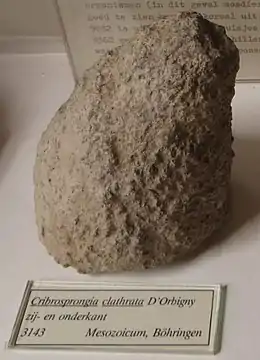Hexactinosida
Звичайні шестипроменеві губки (Hexactinosida) — ряд губок класу шестипроменеві губки (Hexactinellida). Звичайні шестипроменеві губки характеризуються кременистими спікулами, що складаються з шести пересічних променів під прямим кутом. Інші губки мають здатність скорочуватись, звичайні шестипроменеві губки цієї здатності не мають. Звичайні шестипроменеві губки володіють унікальною системою для швидкого проведення електричних імпульсів через їхні тіла, що дозволяє їм швидко реагувати на зовнішні подразники. Звичайні шестипроменеві губки широко розглядається як рання гілка класифікації Porifera, тому є істотні відомості про співіснування звичайних шестипроменевих губок та інших. Зокрема, велика частина їхньої тканини — велика ділянка багатоядерної цитоплазми.
? Звичайні шестипроменеві губки | ||||||||||||||
|---|---|---|---|---|---|---|---|---|---|---|---|---|---|---|
 | ||||||||||||||
| Біологічна класифікація | ||||||||||||||
| ||||||||||||||
Родини | ||||||||||||||
| ||||||||||||||
Посилання | ||||||||||||||
| ||||||||||||||
Класифікація
Має сім родин:
- Родина Aphrocallistidae Gray, 1867
- Родина Craticulariidae Rauff, 1893
- Родина Cribrospongiidae Roemer, 1864
- Родина Dactylocalycidae Gray, 1867
- Родина Euretidae Zittel, 1877
- Родина Farreidae Gray, 1872
- Родина Tretodictyidae Schulze, 1886
Посилання
- Hooper, John N. A., and Rob W. M. van Soest, eds. 2002. Systema Porifera: A Guide to the Classification of Sponges. xlviii + 1708
- Ax. 1996. Multicellular Animals: A New Approach to the Phylogenetic Order in Nature; Springer, Berlin.
- Bergquist, P. R. 1978. Sponges. University of California Press, Berkeley and Los Angeles. 268 pages.
- Dohrmann, M., J. Dorte, J. Reitner, A.G. Collins, and G. Wörheide. 2008. Phylogeny and Evolution of Glass Sponges (Porifera, Hexactinellida). Systematic Biology, 57:388.
- Kozloff, E. N. 1990. Invertebrates. Saunders College Publishing, Philadelphia and other cities. 866 pages.
- Levin, H. L. 1999. Ancient Invertebrates and Their Living Relatives. Prentice Hall, Upper Saddle River. 358 pages.
- Leys, S.P., Mackie, G.O., Reiswig, H.M. 2007. The biology of glass sponges. Advances in Marine Biology. 52:1–145.
- Philippe et al. 2009. Phylogenomics revives traditional views on deep animal relationships. Current Biology, 19:706.
- Ruppert, E. E. and R. D. Barnes. 1994. Invertebrate Zoology: Sixth Edition. Saunders College Publishing. Fort Worth and other cities. 1040 pages.
- Sperling, E.A., J.M. Robinson, D. Pisani, and K.J. Peterson. 2010. Where's the glass? Biomarkers, molecular clocks, and microRNAs suggest a 200-Myr missing Precambrian fossil record of siliceous sponge spicules. Geobiology 8:24.
- Thiel, V., M. Blumenberg, J. Hefter, T. Paper, S. Pomponi, J. Reed, J. Reitner, G. Wörheide, and W. Michaelis. 2002. A chemical view of the most ancient metazoa--biomarker chemotaxonomy of hexactinellid sponges. Naturwissenschaften 89:60.